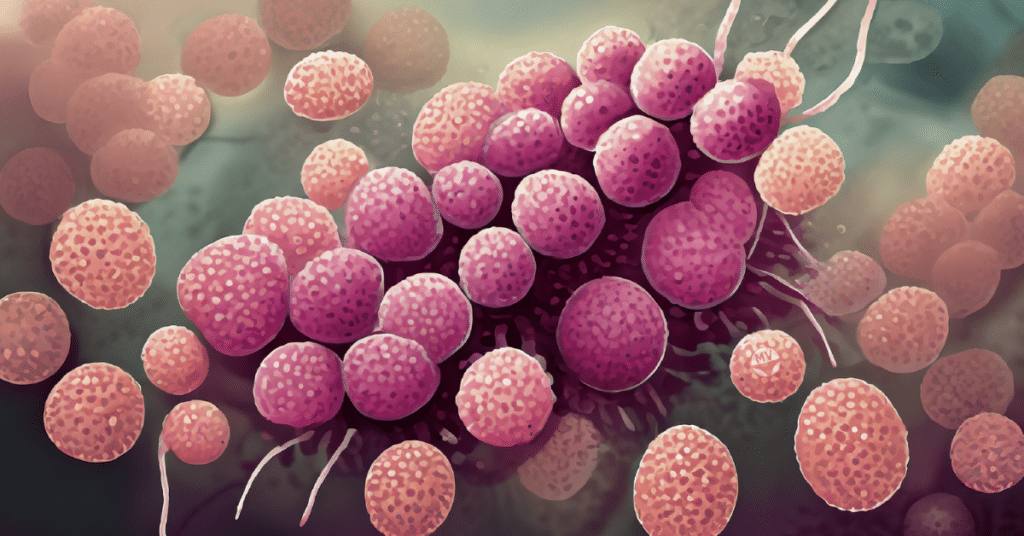Staphylococcus aureus is responsible for severe hospital-acquired infections and, due to the widespread use of antibiotics, has evolved into the most menacing multidrug-resistant pathogen to human health1.
Staphylococcus aureus can also contribute to drug-treatment resistant aerobic vaginitis (AV), vaginal dysbiosis, and urinary tract infections.
Additionally, S. aureus frequently resides within biofilms at the infection site, and the formation of biofilms on various medical surfaces, such as catheters, poses a significant challenge in infections.
Consequently, a variety of antibiotics are employed to eradicate S. aureus biofilms. However, alternatives to existing antibiotics for combatting methicillin-resistant S. aureus (MRSA) biofilm infections continue to be a subject of intense interest.
In this context, recent studies in this field have explored the potential of Cinnamomum and its derivative compounds from cinnamon.
García-Salinas et al2. made a notable discovery that concentrations of cinnamaldehyde exceeding 1 mg/mL effectively eradicated preformed S. aureus biofilms.
In another investigation, C. zeylanicum essential oil (CZEO) and its active ingredient, cinnamaldehyde, were employed to inhibit S. aureus biofilms.
Both substances significantly reduced biofilm formation on stainless steel and polystyrene surfaces. Consequently, the authors postulated that CZEO’s anti-biofilm efficacy is closely tied to cinnamaldehyde, its principal component.
Furthermore, another study3 demonstrated the potent antibiofilm effect of cinnamaldehyde. After 48 hours of treatment, MRSA biofilms were reduced from approximately 53% to over 82%.
As a result, recent research has highlighted Cinnamomum’s antibiofilm effects against S. aureus and MRSA. Nevertheless, the precise antibiofilm mechanisms of these substances remain unidentified in these studies.
In this vein, other investigations have delved into the molecular antibiofilm mechanisms of Cinnamomum and cinnamaldehyde against MRSA. Kot et al.3 reported that cinnamaldehyde efficiently curtailed MRSA biofilm formation, sourced from patients’ anal and wound samples.
Cinnamomum impact on gene expression in S. aureus biofilm formation
Cinnamomum downregulated the expression levels of fib, ebps, and eno genes, which encode fibrinogen binding protein, elastin, and laminin-binding protein, respectively.
Furthermore, cinnamaldehyde treatment led to decreased expression of genes encoding polysaccharide intercellular adhesin (icaD and icaA). The authors posited that by inhibiting fib, ebps, and eno, cinnamaldehyde may actively hinder MRSA adhesion to fibrinogen in the blood, elastin, and laminin surfaces.
Additionally, by reducing the expression of icaD and icaA, cinnamaldehyde could impede intercellular adherence and the accumulation of bacterial cells in biofilms.
Researchers4 employing confocal laser scanning microscopy z-section analyses reported that cinnamaldehyde disrupted MRSA biofilms in a dose-dependent manner and suppressed the expression of sarA.
Notably, the biofilm-associated protein (Bap) plays a crucial role in bacterial adhesion and intercellular accumulation during biofilm formation in icaADBC-independent S. aureus.
SarA regulates the expression of 120 genes in this bacterium and acts as a positive regulator of Bap-mediated biofilm formation. Following bap gene activation via sarA, its expression is closely linked to biofilm formation in icaADBC-independent S. aureus.
Therefore, inhibition of sarA by cinnamaldehyde could contribute to MRSA biofilm inhibition.
Finally, in another study, CTEO disrupted 60-80% of preformed MRSA biofilms. Microscopic examination revealed that CTEO reduced bio-volume and average thickness by disrupting the EPS layer and slime synthesis.
Additionally, Rubini et al.5 found that Cinnamomum oil reduced MRSA haemolytic activity, inhibiting it by 65-80%.
α-haemolysin, a pore-forming toxin, lyses human red blood cells and facilitates biofilm formation by regulating cell interactions6.
As mentioned in the studies above, Cinnamomum, through the downregulation of various MRSA genes, prevents bacterial adhesion to different surfaces and inhibits biofilm maturation.
References
- 1.Shariati A, Moradabadi A, Azimi T, Ghaznavi-Rad E. Wound healing properties and antimicrobial activity of platelet-derived biomaterials. Sci Rep. Published online January 23, 2020. doi:10.1038/s41598-020-57559-w
- 2.García-Salinas S, Elizondo-Castillo H, Arruebo M, Mendoza G, Irusta S. Evaluation of the Antimicrobial Activity and Cytotoxicity of Different Components of Natural Origin Present in Essential Oils. Molecules. Published online June 8, 2018:1399. doi:10.3390/molecules23061399
- 3.Kot B, Wierzchowska K, Grużewska A, Lohinau D. The effects of selected phytochemicals on biofilm formed by five methicillin-resistant Staphylococcus aureus. Natural Product Research. Published online June 18, 2017:1299-1302. doi:10.1080/14786419.2017.1340282
- 4.Jia P, Xue YJ, Duan XJ, Shao SH. Effect of cinnamaldehyde on biofilm formation and sarA expression by methicillin-resistant Staphylococcus aureus. Letters in Applied Microbiology. Published online August 8, 2011:409-416. doi:10.1111/j.1472-765x.2011.03122.x
- 5.Rubini D, Banu SF, Nisha P, et al. Essential oils from unexplored aromatic plants quench biofilm formation and virulence of Methicillin resistant Staphylococcus aureus. Microbial Pathogenesis. Published online September 2018:162-173. doi:10.1016/j.micpath.2018.06.028
- 6.Caiazza NC, O’Toole GA. Alpha-Toxin Is Required for Biofilm Formation by Staphylococcus aureus. J Bacteriol. Published online May 15, 2003:3214-3217. doi:10.1128/jb.185.10.3214-3217.2003

Get a fresh perspective with a qualified, experienced vulvovaginal specialist naturopath.
This product has multiple variants. The options may be chosen on the product page
The most comprehensive vaginal microbiome test you can take at home, brought to you by world-leading vaginal microbiome scientists at Juno Bio.
Easy-to-use BV and AV treatment program.

Promote and support a protective vaginal microbiome with tailored probiotic species.






